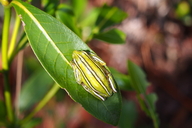|
Description
A medium-sized species of Heterixalus with a very distinctive coloration; males and females both 25 mm (three males from Ambatolampy measure 25-27 mm). Back light green, with five longitudinal white bands bordered by dark brown stripes. Two parallel longitudinal bands of the same coloration on the lateral sides of the lower limb and shank, and one along the tarsus and foot. Thighs, ventral surface of limbs, and hands and feet are orange. Venter is creamish; throat white with brown markings in one female. Tibiotarsal articulation does not reach the eye. Males have a single, black subgular vocal sac. Gular gland of different shape than in other species of Heterixalus.
Calls of H. rutenbergi are different from other species of Heterixalus. A call consists of a single, very intense, pulsed note (only one note type was heard). A note lasts 350-400 ms and consists of 10-15 distinct pulses (duration 9-12 ms, interval between pulses 14-19 ms). Calls are repeated after 3-5 seconds. Frequency is 2.5-3 kHz.
Similar species : The distinctive coloration allows easy differentiation from other species of Heterixalus.
Distribution and Habitat
Country distribution from AmphibiaWeb's database: Madagascar
20 km W of Antananarivo, Ambatofitoharanana, Ambatolampy, Ambohitantely, Antratrabe, Itremo, Mantasoa, Tsinjoarivo. This species occurs throughout the central plateau of Madagascar from 1,200-1,500m asl. It inhabits montane grassland, croplands, and disturbed areas, but not rice fields (Andreone et al. 2008).
Life History, Abundance, Activity, and Special Behaviors
One female was found in grassland, altitude 1300 m. Calling males were found at night in January in a sun-exposed moorland swamp near Ambatolampy, syntopically with H. betsileo . No specimens were heard in the rice fields where H. betsileo was abundant.
Eggs and tadpoles are unknown.
Habits: Swamps in moorland at relatively high elevations (above 1000 m). Apparently not populating rice fields, and more selective in habitat choice than most other Heterixalus.
Breeding occurs in specialized habitat, preferably acidic brown waters in permanent and temporary bodies of water (Andreone et al. 2008). Trends and Threats
Near Threatened: the species depends on a specialized breeding habitat, and its area of occupancy is probably not much greater than 2,000 km2, and the extent and quality of its habitat is declining, thus making the species close to qualifying for Vulnerable. It probably occurs in the R�serve Sp�ciale d�Ambohitantely, and perhaps in other protected areas (Andreone et al. 2008). Possible reasons for amphibian decline Intentional mortality (over-harvesting, pet trade or collecting)
Comments
Taken with permission from Glaw and Vences (2007).
References
Andreone, F., Vences, M., and Glaw, F. (2008). Heterixalus rutenbergi. In: IUCN 2008. 2008 IUCN Red List of Threatened Species. www.iucnredlist.org. Downloaded on 21 April 2009.
Glaw, F., and Vences, M. (2007). Field Guide to the Amphibians and Reptiles of Madagascar. Third Edition. Vences and Glaw Verlag, Köln.
Originally submitted by: Miguel Vences and Frank Glaw (first posted 2002-02-08)
Edited by: Henry Zhu (2010-07-18)Species Account Citation: AmphibiaWeb 2010 Heterixalus rutenbergi <https://amphibiaweb.org/species/493> University of California, Berkeley, CA, USA. Accessed Jan 21, 2025.
Feedback or comments about this page.
Citation: AmphibiaWeb. 2025. <https://amphibiaweb.org> University of California, Berkeley, CA, USA. Accessed 21 Jan 2025.
AmphibiaWeb's policy on data use.
|
